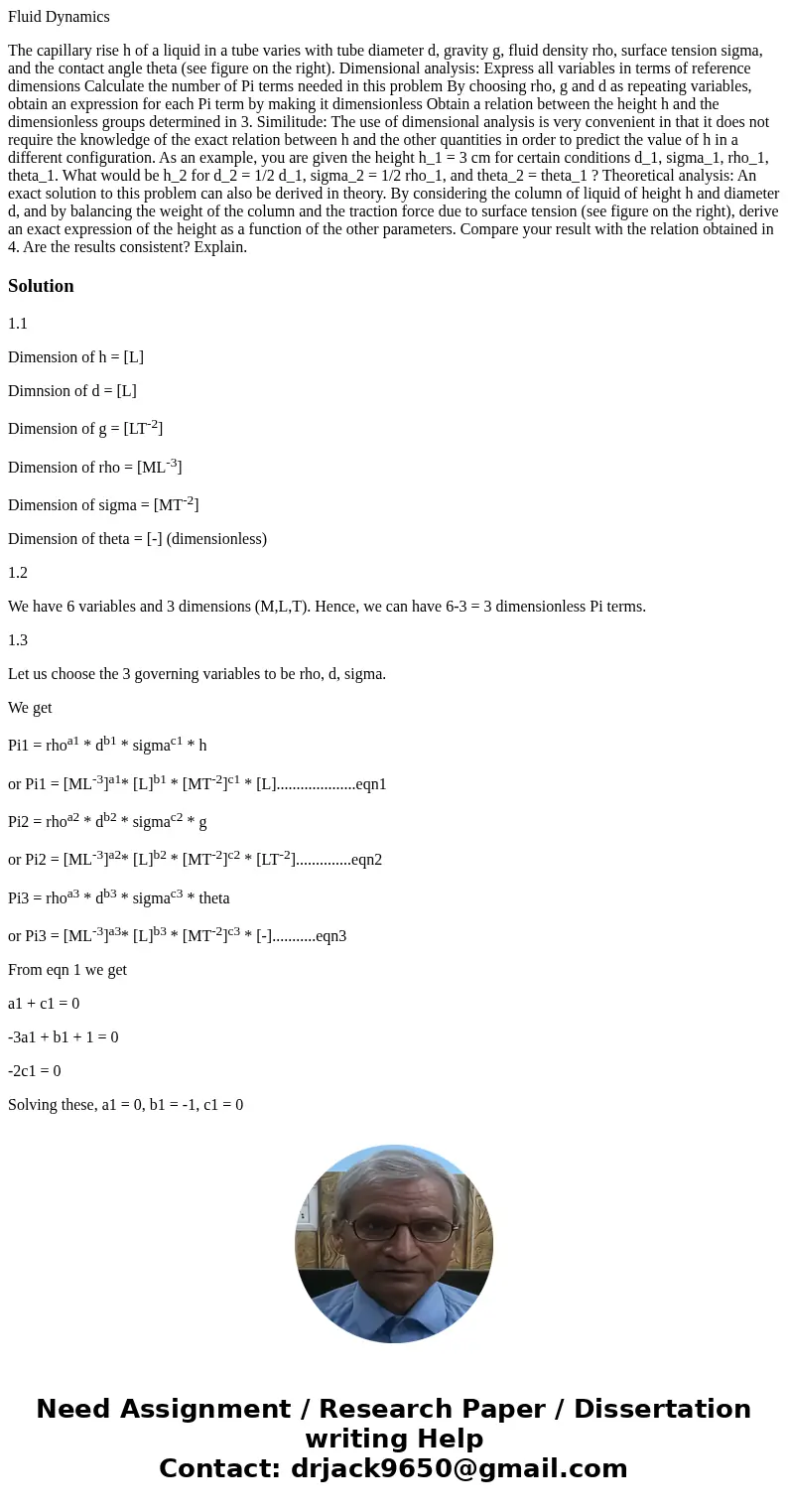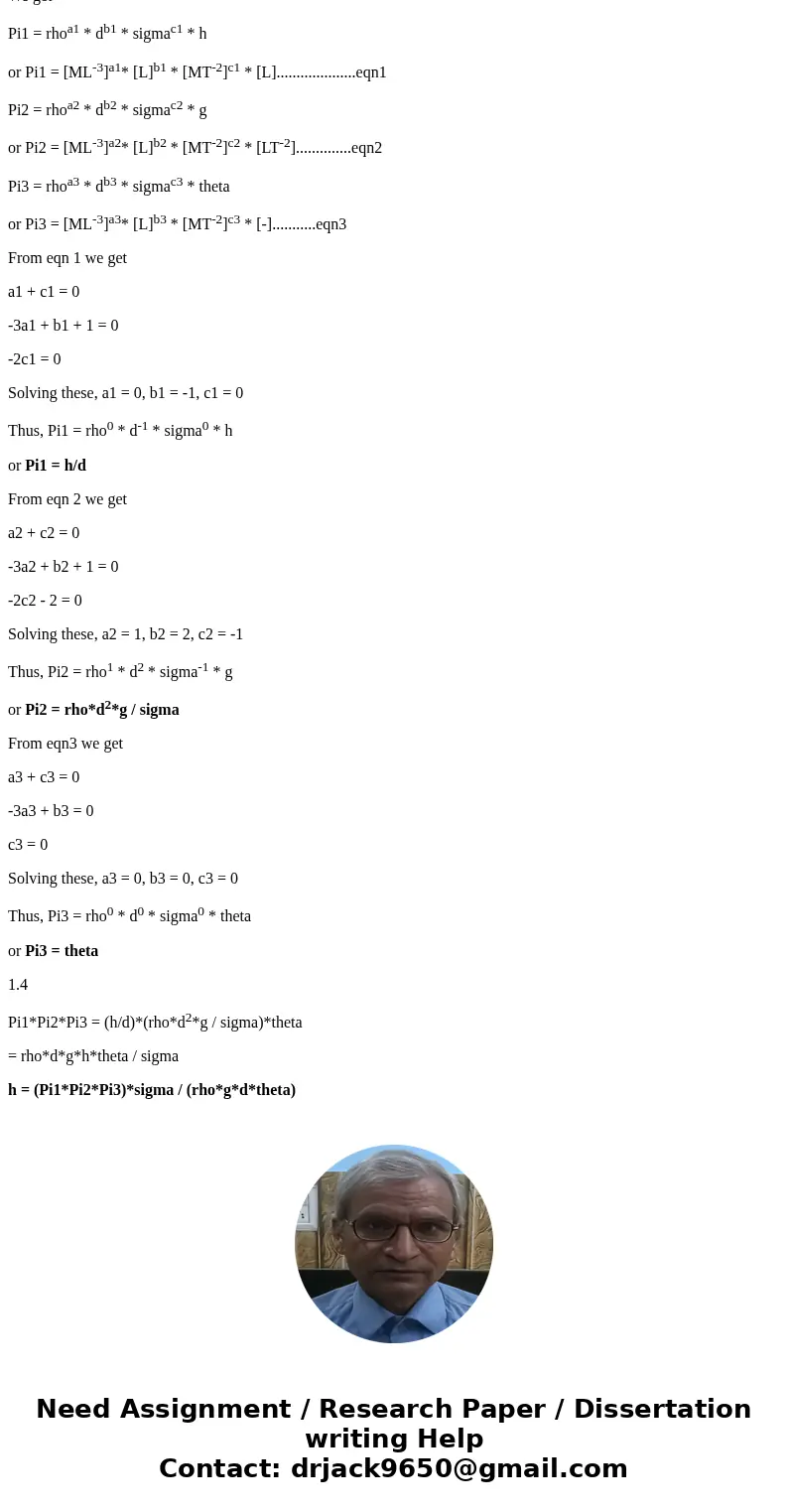Fluid Dynamics The capillary rise h of a liquid in a tube va
Fluid Dynamics
The capillary rise h of a liquid in a tube varies with tube diameter d, gravity g, fluid density rho, surface tension sigma, and the contact angle theta (see figure on the right). Dimensional analysis: Express all variables in terms of reference dimensions Calculate the number of Pi terms needed in this problem By choosing rho, g and d as repeating variables, obtain an expression for each Pi term by making it dimensionless Obtain a relation between the height h and the dimensionless groups determined in 3. Similitude: The use of dimensional analysis is very convenient in that it does not require the knowledge of the exact relation between h and the other quantities in order to predict the value of h in a different configuration. As an example, you are given the height h_1 = 3 cm for certain conditions d_1, sigma_1, rho_1, theta_1. What would be h_2 for d_2 = 1/2 d_1, sigma_2 = 1/2 rho_1, and theta_2 = theta_1 ? Theoretical analysis: An exact solution to this problem can also be derived in theory. By considering the column of liquid of height h and diameter d, and by balancing the weight of the column and the traction force due to surface tension (see figure on the right), derive an exact expression of the height as a function of the other parameters. Compare your result with the relation obtained in 4. Are the results consistent? Explain.Solution
1.1
Dimension of h = [L]
Dimnsion of d = [L]
Dimension of g = [LT-2]
Dimension of rho = [ML-3]
Dimension of sigma = [MT-2]
Dimension of theta = [-] (dimensionless)
1.2
We have 6 variables and 3 dimensions (M,L,T). Hence, we can have 6-3 = 3 dimensionless Pi terms.
1.3
Let us choose the 3 governing variables to be rho, d, sigma.
We get
Pi1 = rhoa1 * db1 * sigmac1 * h
or Pi1 = [ML-3]a1* [L]b1 * [MT-2]c1 * [L]....................eqn1
Pi2 = rhoa2 * db2 * sigmac2 * g
or Pi2 = [ML-3]a2* [L]b2 * [MT-2]c2 * [LT-2]..............eqn2
Pi3 = rhoa3 * db3 * sigmac3 * theta
or Pi3 = [ML-3]a3* [L]b3 * [MT-2]c3 * [-]...........eqn3
From eqn 1 we get
a1 + c1 = 0
-3a1 + b1 + 1 = 0
-2c1 = 0
Solving these, a1 = 0, b1 = -1, c1 = 0
Thus, Pi1 = rho0 * d-1 * sigma0 * h
or Pi1 = h/d
From eqn 2 we get
a2 + c2 = 0
-3a2 + b2 + 1 = 0
-2c2 - 2 = 0
Solving these, a2 = 1, b2 = 2, c2 = -1
Thus, Pi2 = rho1 * d2 * sigma-1 * g
or Pi2 = rho*d2*g / sigma
From eqn3 we get
a3 + c3 = 0
-3a3 + b3 = 0
c3 = 0
Solving these, a3 = 0, b3 = 0, c3 = 0
Thus, Pi3 = rho0 * d0 * sigma0 * theta
or Pi3 = theta
1.4
Pi1*Pi2*Pi3 = (h/d)*(rho*d2*g / sigma)*theta
= rho*d*g*h*theta / sigma
h = (Pi1*Pi2*Pi3)*sigma / (rho*g*d*theta)


 Homework Sourse
Homework Sourse